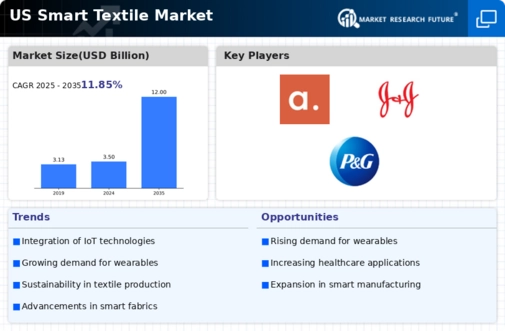The smart textile market is currently characterized by a dynamic competitive landscape, driven by innovation, technological advancements, and increasing consumer demand for multifunctional fabrics. Key players such as Nike Inc (US), Under Armour (US), and Textronics (US) are at the forefront, each adopting distinct strategies to enhance their market positioning. Nike Inc (US) focuses on integrating advanced materials into its product lines, emphasizing sustainability and performance. Under Armour (US) has been investing heavily in research and development to create smart textiles that monitor athletic performance, while Textronics (US) leverages its expertise in electronic textiles to expand its offerings in health monitoring applications. Collectively, these strategies contribute to a competitive environment that is increasingly centered around innovation and consumer-centric solutions.
In terms of business tactics, companies are localizing manufacturing and optimizing supply chains to enhance responsiveness to market demands. The competitive structure of the smart textile market appears moderately fragmented, with several players vying for market share. However, the influence of major companies is substantial, as they set trends and standards that smaller firms often follow. This interplay between established brands and emerging players fosters a vibrant ecosystem where innovation thrives.
In October 2025, Nike Inc (US) announced a partnership with a leading tech firm to develop a new line of smart athletic wear that incorporates AI-driven performance analytics. This strategic move is significant as it not only enhances Nike's product offerings but also positions the company as a leader in the integration of technology and sportswear, potentially attracting a tech-savvy consumer base.
In September 2025, Under Armour (US) launched a new smart textile line that features embedded sensors capable of tracking hydration levels and body temperature. This initiative underscores Under Armour's commitment to enhancing athletic performance through data-driven insights, which may resonate well with health-conscious consumers. The ability to provide real-time feedback could redefine user engagement in the sports apparel sector.
In August 2025, Textronics (US) expanded its collaboration with healthcare providers to integrate its smart textiles into patient monitoring systems. This strategic action highlights the growing intersection of healthcare and smart textiles, suggesting a potential shift in market focus towards health applications. By aligning with healthcare needs, Textronics may tap into a lucrative segment that prioritizes wellness and preventive care.
As of November 2025, current trends in the smart textile market indicate a strong emphasis on digitalization, sustainability, and AI integration. Strategic alliances are increasingly shaping the competitive landscape, allowing companies to pool resources and expertise to drive innovation. Looking ahead, it appears that competitive differentiation will evolve from traditional price-based competition to a focus on technological advancements, innovative solutions, and reliable supply chains. This shift may redefine market dynamics, compelling companies to prioritize R&D and consumer engagement to maintain a competitive edge.














Leave a Comment